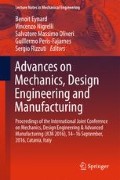Abstract
Additive manufacturing is a rapidly expanding technology. It allows the creation of very complex 3D objects by adding layers of material, in spite of the traditional production systems based on the removal of material. The development of additive technology has produced initially a generation of additive manufacturing techniques restricted to industrial applications, but their extraordinary degree of innovation has allowed the spreading of household systems. Nowadays, the most common domestic systems produce 3D parts through a fused deposition modeling process. Such systems have low productivity and make, usually, objects with no high accuracy and with unreliable mechanical properties. These side effects can depend on the process parameters. Aim of this work is to study the influence of some typical parameters of the additive manufacturing process on the prototypes characteristics. In particular, it has been studied the influence of the layer thickness on the shape and dimensional accuracy. Cylindrical specimens have been created with a 3D printer, the Da Vinci 1.0A by XYZprinting, using ABS filaments. Dimensional and shape inspection of the printed components has been performed following a typical reverse engineering approach. In particular, the point clouds of the surfaces of the different specimens have been acquired through a 3D laser scanner. After, the acquired point clouds have been post-processed, converted into 3D models and analysed to detect any shape or dimensional difference from the initial CAD models. The obtained results may constitute a useful guideline to choose the best set of the process parameters to obtain printed components of good quality in a reasonable time and minimizing the waste of material.
Access this chapter
Tax calculation will be finalised at checkout
Purchases are for personal use only
Preview
Unable to display preview. Download preview PDF.
References
Bikas, H., Stavropoulos, P., Chryssolouris, G., Additive manufacturing methods and modeling approaches: A critical review, 2016, International Journal of Advanced Manufacturing Technology, 83 (1-4), pp. 389-405
Guo, N., Leu, M.C., Additive manufacturing: Technology, applications and research needs, 2013, Frontiers of Mechanical Engineering, 8 (3), pp. 215-243
Lanzotti, A., Del Giudice, D.M., Lepore, A., Staiano, G., Martorelli, M., On the geometric accuracy of RepRap open-source three-dimensional printer, 2015, Journal of Mechanical Design, Transactions of the ASME, 137 (10), art. no. 101703
Cerniglia, D., Montinaro, N., Nigrelli, V., Detection of disbonds in multi-layer structures by laser-based ultrasonic technique, 2008, Journal of Adhesion, 84 (10), pp. 811-829
Boschetto, A., Bottini, L.,Accuracy prediction in fused deposition modelling, 2014, International Journal of Advanced Manufacturing Technology, 73 (5-8), pp. 913-928
Ingrassia, T., Mancuso, A., Nigrelli, V., Tumino, D., Numerical study of the components positioning influence on the stability of a reverse shoulder prosthesis (2014) International Journal on Interactive Design and Manufacturing, 8 (3), pp. 187-197
Lanzotti, A., Martorelli, M., Staiano, G., Understanding process parameter effects of reprap open-source three-dimensional printers through a design of experiments approach, 2015, Journal of Manufacturing Science and Engineering, Transactions of the ASME, 137 (1), art. no. 011017
Boschetto, A., Bottini, L., Design for manufacturing of surfaces to improve accuracy in Fused Deposition Modeling, 2016, Robotics and Computer-Integrated Manufacturing, 37, art. no. 1357, pp. 103-114
Vaezi, M., Chua, C.K., Effects of layer thickness and binder saturation level parameters on 3D printing process, 2011, International Journal of Advanced Manufacturing Technology, 53 (1-4), pp. 275-284
Dai, X., Xie, H., Constitutive parameter identification of 3D printing material based on the virtual fields method, 2015, Measurement: Journal of the International Measurement Confederation, 59, pp. 38-43
Ingrassia, T., Mancuso, A., Nigrelli, V., Tumino, D., A multi-technique simultaneous approach for the design of a sailing yacht, 2015, International Journal on Interactive Design and Manufacturing, DOI: 10.1007/s12008-015-0267-2
Cappello, F., Ingrassia, T., Mancuso, A., Nigrelli, V., Methodical redesign of a semitrailer, 2005, WIT Transactions on the Built Environment, 80, pp. 359-369
Nalbone, L., et al., Optimal positioning of the humeral component in the reverse shoulder prosthesis, 2014, Musculoskeletal Surgery, 98 (2), pp. 135-142.
Cerniglia, D., Ingrassia, T., D’Acquisto, L., Saporito, M., Tumino, D., Contact between the components of a knee prosthesis: Numerical and experimental study, 2012, Frattura ed Integrita Strutturale, 22, pp. 56-68
Ingrassia, T., Nigrelli, V., Design optimization and analysis of a new rear underrun protective device for truck, 2010, Proceedings of the 8th International Symposium on Tools and Methods of Competitive Engineering, TMCE 2010, 2, pp. 713-725
Ingrassia, T., Mancuso, A., Virtual prototyping of a new intramedullary nail for tibial fractures, 2013, International Journal on Interactive Design and Manufacturing, 7 (3), pp. 159-169
Jecić, S., Drvar, N., The assessment of structured light and laser scanning methods in 3d shape measurements. 4th International Congress of Croatian Society of Mechanics September, 18-20, 2003
Tóth, T., Živčák, J., A comparison of the outputs of 3D scanners, 2014, Procedia Engineering, 69, pp. 393-401
Author information
Authors and Affiliations
Corresponding author
Editor information
Editors and Affiliations
Rights and permissions
Copyright information
© 2017 Springer International Publishing AG
About this chapter
Cite this chapter
Ingrassia, T., Nigrelli, V., Ricotta, V., Tartamella, C. (2017). Process parameters influence in additive manufacturing. In: Eynard, B., Nigrelli, V., Oliveri, S., Peris-Fajarnes, G., Rizzuti, S. (eds) Advances on Mechanics, Design Engineering and Manufacturing . Lecture Notes in Mechanical Engineering. Springer, Cham. https://doi.org/10.1007/978-3-319-45781-9_27
Download citation
DOI: https://doi.org/10.1007/978-3-319-45781-9_27
Published:
Publisher Name: Springer, Cham
Print ISBN: 978-3-319-45780-2
Online ISBN: 978-3-319-45781-9
eBook Packages: EngineeringEngineering (R0)

